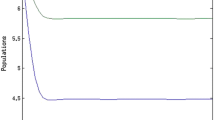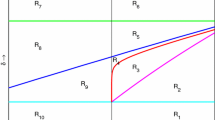Abstract
We present two models which incorporate prey harvesting to the classical and a modified ratio-dependent predator–prey model with additional food supply to the predators. We analyze the existence and stability of the equilibrium points of both the models and determine the maximum sustainable harvesting effort. The optimal harvesting policy is determined by using Pontryagin’s maximum principle. The results obtained are numerically illustrated. We examine the consequences of providing additional food (as a part of the total harvest effort) to predators in prey harvesting. Our study shows that the system can sustain a much improved optimal prey harvesting rate with additional food supply.









Similar content being viewed by others
References
Kot, M.: Elements of Mathematical Ecology. Cambridge University Press, Cambridge (2001)
Holling, C.S.: The components of predation as revealed by a study of small-mammal predation of the European pine sawfly. Can. Entomol. 91(5), 293–320 (1959)
Holling, C.S.: The functional response of predators to prey density and its role in mimicry and population regulation. Mem. Entomol. Soc. Can. 97(S45), 5–60 (1965)
Holling, C.S.: The functional response of invertebrate predators to prey density. Mem. Entomol. Soc. Can. 98(S48), 5–86 (1966)
Arditi, R., Ginzburg, L.R.: Coupling in predator–prey dynamics: ratio-dependence. J. Theor. Biol. 139(3), 311–326 (1989)
Kuang, Y., Beretta, E.: Global qualitative analysis of a ratio-dependent predator–prey system. J. Math. Biol. 36(4), 389–406 (1998)
Xiao, D., Ruan, S.: Global dynamics of a ratio-dependent predator–prey system. J. Math. Biol. 43(3), 268–290 (2001)
Jost, C., Arino, O., Arditi, R.: About deterministic extinction in ratio-dependent predator–prey models. Bull. Math. Biol. 61(1), 19–32 (1999)
Ji, C., Jiang, D., Li, X.: Qualitative analysis of a stochastic ratio-dependent predator–prey system. J. Comput. Appl. Math. 235(5), 1326–1341 (2011)
Aly, S., Kim, I., Sheen, D.: Turing instability for a ratio-dependent predator–prey model with diffusion. Appl. Math. Comput. 217(17), 7265–7281 (2011)
Song, Y., Zou, X.: Bifurcation analysis of a diffusive ratio-dependent predator–prey model. Nonlinear. Dyn. (2014). doi:10.1007/s11071-014-1421-2
Clark, C.W.: Mathematical Bioeconomics: The Optimal Management of Renewable Resources. Wiley, New York (1990)
Goh, B.S.: Management and Analysis of Biological Populations. Elsevier, Amsterdam (1980)
Srinivasu, P.D.N.: Bioeconomics of a renewable resource in presence of a predator. Nonlinear Anal-Real 2(4), 497–506 (2001)
Hoekstra, J., van den Bergh, J.C.J.M.: Harvesting and conservation in a predator–prey system. J. Econ. Dyn. Control. 29(6), 1097–1120 (2005)
Xiao, D., Jennings, L.S.: Bifurcations of a ratio-dependent predator–prey system with constant rate harvesting. SIAM J. Appl. Math. 65(3), 737–753 (2005)
Lenzini, P., Rebaza, J.: Nonconstant predator harvesting on ratio-dependent predator–prey models. Appl. Math. Sci. 4(16), 791–803 (2010)
Kar, T.K., Ghosh, B.: Sustainability and optimal control of an exploited prey–predator system through provision of alternative food to predator. Biosystems 109(2), 220–232 (2012)
Lv, Y., Yuan, R., Pei, Y.: A prey-predator model with harvesting for fishery resource with reserve area. Appl. Math. Model. 37(5), 3048–3062 (2013)
Jana, S., Kar, T.K.: A mathematical study of a prey–predator model in relevance to pest control. Nonlinear Dyn. 74(3), 667–683 (2013)
Sharma, S., Samanta, G.P.: Optimal harvesting of a two species competition model with imprecise biological parameters. Nonlinear Dyn. 77(4), 1101–1119 (2014)
Srinivasu, P.D.N., Prasad, B.S.R.V., Venkatesulu, M.: Biological control through provision of additional food to predators: a theoretical study. Theor. Popul. Biol. 72(1), 111–120 (2007)
van Baalen, M., Krivan, V., van Rijn, P.C.J., Sabelis, M.W.: Alternative food, switching predators, and the persistence of predator–prey systems. Am. Nat. 157(5), 512–524 (2001)
Perko, L.: Differential Equations and Dynamical Systems. Springer, New York (2001)
Chiang, A.C.: Elements of Dynamic Optimization. McGraw-Hill, New York (1992)
Chaudhuri, K.: Dynamic optimization of combined harvesting of a two-species fishery. Ecol. Model. 41(1–2), 17–25 (1988)
Acknowledgments
The first author is grateful to the Indian Institute of Technology Guwahati for the financial support provided to pursue his Ph.D. The authors express their gratitude to both the learned reviewers for their suggestions, which resulted in an improved manuscript.
Author information
Authors and Affiliations
Corresponding author
Rights and permissions
About this article
Cite this article
Kumar, D., Chakrabarty, S.P. A comparative study of bioeconomic ratio-dependent predator–prey model with and without additional food to predators. Nonlinear Dyn 80, 23–38 (2015). https://doi.org/10.1007/s11071-014-1848-5
Received:
Accepted:
Published:
Issue Date:
DOI: https://doi.org/10.1007/s11071-014-1848-5




